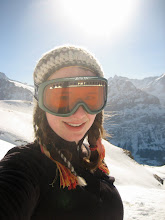
It was in the middle of the Fjord that we live on the shores of. The governor was a bit worried about it though- so a few hours later they tranquilized it and helecoptered it out of town.





68.7% of the world's freshwater is stored in ice at the poles and at elevation. Despite this huge reservoir of our most important natural resource, staggeringly little is known about the cryosphere and its interaction with global climate. Glaciers are effectively just ice that has accumulated over time and moves under its own weight, but they have a major impact on sea level and freshwater supply for humans. All this is just to say that understanding glacial hydrology is pretty important. In the last several years it has come to light that the predominant theory of water movement through glaciers (the Shreve model) that is the basis for effectively all studies of glacial hydrology is… less than accurate. In fact, it may be fully wrong in predicting water movement through glaciers in particularly cold regions of the world.
The term project that I'm donning here at UNIS involves sensing of meltwater channels in glaciers. I'm comparing maps of meltwater channels that were made through glaciospeleleology (ice caving!) with ground-penetrating radar data from the surface to see how good of a job the GPR does of mapping the meltwater channels. In places like Greenland where the ice sheets are huge, it is much more practical to try to map the channels from the surface, so it is important to know how good of a job GPR does at sensing the channels. I'm really excited about this work and hope to continue it in the future (I'm even talking with my professor about turning it into a masters project..).


Here's how it works: someone builds a cabin (read: 4 walls and a roof, a bit of insulation, a coal stove, some bunk beds). They use it when they want, but leave it open the rest of the time for passing travelers. The only expectations: clean it when you're done and be sure to write in the guest book. The student group here at my university owns two particularly nice cabins that are perfect for weekend get-aways. It is truly splendid to be able to plan a trip into the middle of the bone-chilling arctic wilderness, knowing that a soon-warm cabin and almost-comfortable bed awaits.
The idea of sharing cabins fits right in with the 'svalbard faith' concerning everything else. Doors on houses are always left unlocked. Keys are left in cars and snowmobiles. Skis are left outside. Broken snowmobiles are miraculously found on top of the hill that they were stuck at the bottom of. Expensive outdoor equipment is loaned without the blink of an eye. We even have a free store. Think goodwill, but everything is free. The huge fluffy (almost brand-new) down coat that I live in up here was found there, as were most of my wool socks. The generosity, caring, and faith in one another that is found here is unparalleled by anything I've seen elsewhere in the world. I'm going to miss it dearly.


 I was able to take pictures outside the facility, but security was much tighter inside. Inside the huge round ball is a rather impressive satellite dish.
I was able to take pictures outside the facility, but security was much tighter inside. Inside the huge round ball is a rather impressive satellite dish. 